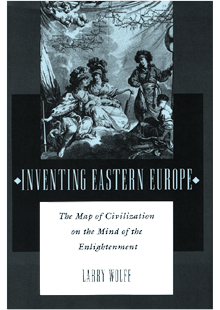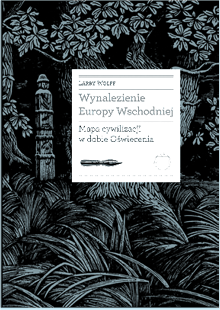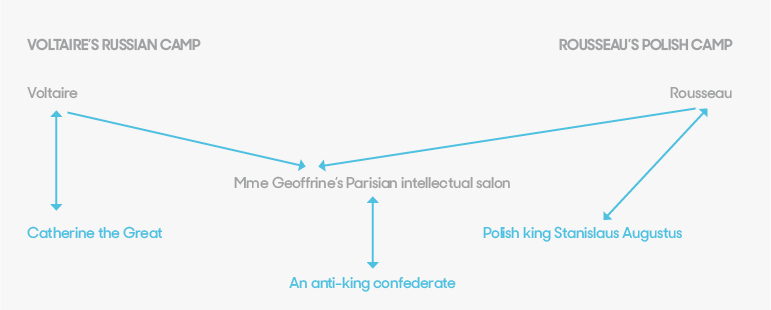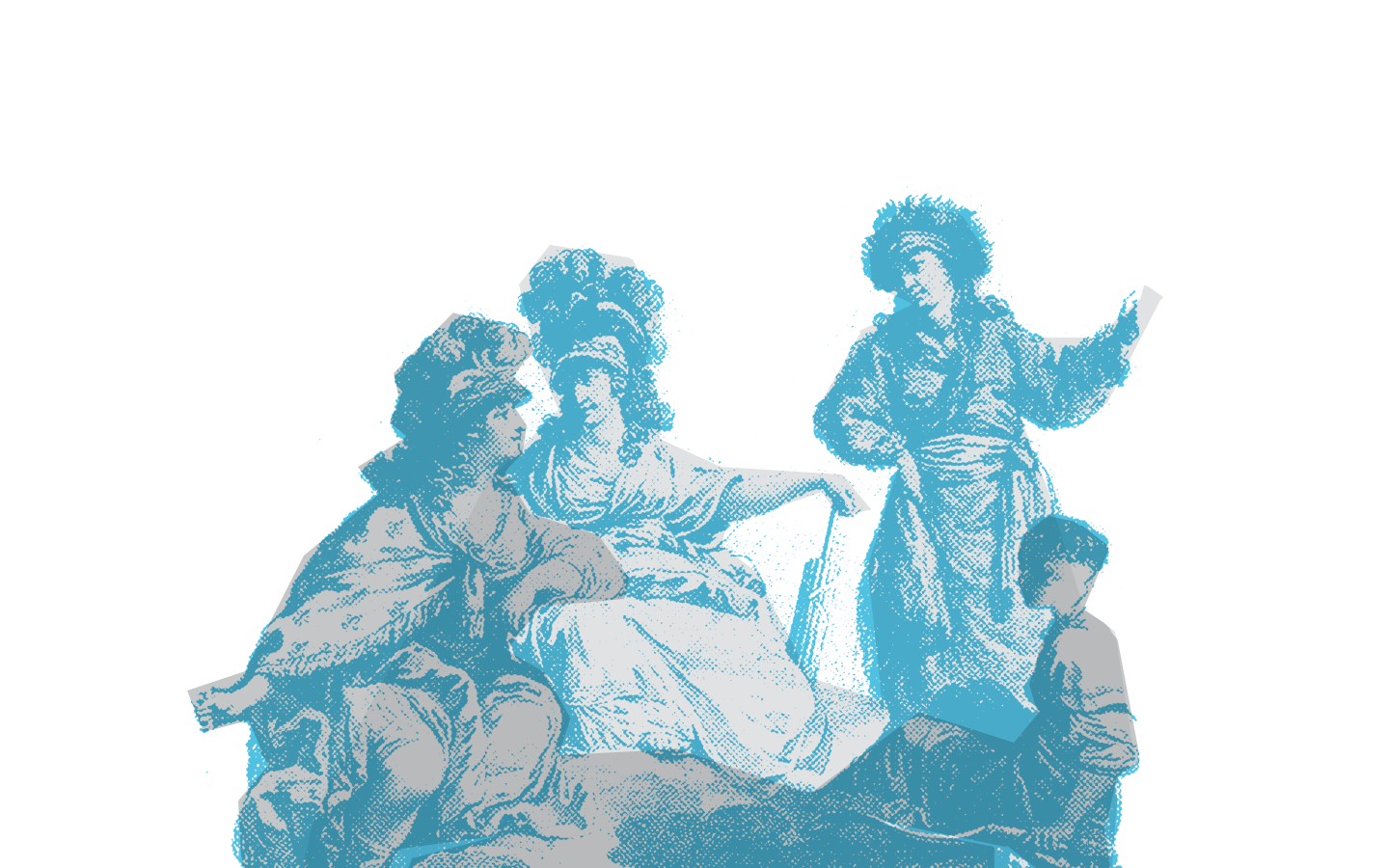 Inventing Eastern Europe: The Map of Civilization on the Mind of the Enlightenment, Larry Wolff, Stanford University Press, 1994;
Inventing Eastern Europe: The Map of Civilization on the Mind of the Enlightenment, Larry Wolff, Stanford University Press, 1994;
Wynalezienie Europy Wschodniej. Mapa cywilizacji w dobie Oświecenia, Larry Wolff, translated by Tomasz Bieroń, International Cultural Centre, 2020;
 Woodrow Wilson and the Reimagining of Eastern Europe, Larry Wolff, Princeton University Press 2020.
Woodrow Wilson and the Reimagining of Eastern Europe, Larry Wolff, Princeton University Press 2020.
Over his more than 30-year-long academic career, Larry Wolff has written many books about how the West met Eastern Europe in different eras. In late 2020, the Central Europe Library of the International Cultural Centre in Kraków, Poland, published Wynalezienie Europy Wschodniej. Mapa cywilizacji w dobie Oświecenia [original title Inventing Eastern Europe: The Map of Civilization in the Mind of the Enlightenment] translated by Tomasz Bieroń. Around the same time, Wolff published his latest book Woodrow Wilson and the Reimagining of Eastern Europe, [Princeton University Press 2020]. In the more than 25 years separating the original publication of Inventing and Woodrow Wilson, writing fashions among historians have changed and Wolff has carefully followed them. He has shifted his position from that of a scholar struggling for recognition in the mid-1990s to an authority in Central European history today. What does Wolff’s work tell us about Eastern Europe’s past and its relationship to the West? What picture of the region emerges from the historical documents analyzed by Wolff and from his comments, interpretive decisions and omissions?
Both books portray Eastern Europe as a region inhabited by people without political or personal agency; people of exuberant emotionality, prone to either masochistic subservience or arrogant megalomania; a region of contrasts between scrofulous peasants and sumptuous palaces in the late eighteenth century, between eminent artists and intellectuals (Ignacy Penderecki and Tomáš Masaryk) and villagers smelling of barns. The messages of the two books are slightly different. While Inventing tells the story of how French, Italian, English, and German travellers and intellectuals sketched an image of Eastern Europe in the age of the Enlightenment, Woodrow Wilson depicts an American politician/president who, along with his French and British colleagues, drew actual borders on the map of the region and agreed on constitutions for the countries here.
Inventing Eastern Europe
The book Inventing analyzes Eastern European impressions, reflections, diaries, letters, memoirs and essays by Western European travellers, diplomats and intellectuals of the late eighteenth and early nineteenth centuries, as well as the writings of Rousseau, Voltaire and Herder. This book set itself two detailed tasks: 1) to reconstruct the borders of Eastern Europe as they formed in the minds of eighteenth-century Europeans, and 2) to reconstruct the image of the areas considered to be Eastern Europe at the time.
The political geography of the Enlightenment ranges from the western borders of the former Commonwealth to Siberia.
Wolff’s analysis of the documents led him to the conclusion that the concept of Eastern Europe was formed precisely in the age of the Enlightenment, with its characteristic need to measure, order, classify, and create hierarchies, an age full of adoration for progress and modernity, faith in civilisation, and the imperial and increasingly organized expansion of Europe. The political geography of the Enlightenment (with an unclear position for Greece, the cradle of Western civilization after all) ranges from the western borders of the former Commonwealth to Siberia. The main common feature of this vast area and its culture was, according to eighteenth-century observers, its position on the scale of progress and civilization, with its maximum marked by Enlightenment France and its minimum by Barbaria, that is Turkish and Tartar Asia.
In the first few chapters, Wolff presents a static Enlightenment image of filthy houses in a state of decay adjacent to lavish palaces and serfs submissive to their masters. As the author argues in the introduction, this image persisted unaltered in the Western European imagination, as Churchill’s post-Yalta rhetoric was to testify.
Today, 25 years after I read the book for the first time, I find chapters 5 and 6, where Wolff analyzes Voltaire’s writings on Russia and Rousseau’s on Poland respectively, most interesting. These chapters demonstrate the strange and fascinating relationship between Eastern European politicians and French intellectuals. In the showdown between Tsarina Catherine’s Russia and Stanislaus Augustus’ Commonwealth, Voltaire supported Russia and the Tsarina, while Rousseau supported Poland and the patriotic Bar Confederation, which accused the King of being subservient to the Tsarina. Wolff asserts that in the second half of the eighteenth century, the crisis and subsequent partitions of the Commonwealth were the favourite subject of salon discussions in France. Parisian intellectuals and their fan bases treated the Polish case as an opportunity to test their political projects.
The figure below demonstrates the influence of Eastern European politicians and French intellectuals and Parisian salons as Wolff discovered it. I dream of a series in the style of The Great or a movie in the style of Catherine with Helen Mirren, where this political-salon game would be depicted. The power of personal emotions and intellectual skirmishes guarantees a full-blooded story.

Wolff argues that Stanislaus Augustus was still in love with Tsarina Catherine when she, having installed him on the Polish throne, pushed him away. He also analyzes the lifelong correspondence between Stanislaus Augustus and Madame Geoffrine, the sponsor of one of the most important intellectual salons in Paris in the second half of the eighteenth century. According to Wolff, several volumes of Voltaire’s history of Russia and his decades-long correspondence with Catherine were the result of the philosopher’s admiration for the German-born Russian ruler and the hopes he placed in her. And Rousseau’s Considerations on Polish Government (1772) was said to owe much to a certain Bar confederate, an enemy of Stanislaus Augustus and Russia.
Cultural criticism, practiced in the form of discourse analysis of a geo-cultural region, is a very well established method. It derives from Edward W. Said’s Orientalism, first published in 1978 and reissued many times. The work provides an in-depth picture of the development of reflection and attitude towards the Orient, a concept that, according to the author, “has made it possible to better define Europe (the West) – as an opposite image, ideal, personality, experience”. (Said 1991). Analysing European fiction, ethnographic and linguistic studies, as well as political (colonial) activity and economic exploitation, Said tried to reproduce, and in so doing, to expose, “a style of thinking based on an ontological and epistemological distinction between East and (mostly) West”. (Said 1991: 25)
Following in Said’s footsteps, Wolff attempts to present an analogous picture of the geographic and cultural creation of Eastern Europe. Wolff follows Said when he argues that just as the Orient was invented by nineteenth-century English and French colonizers and equipped by them with mysteriousness, slowness, sensuality and magic, Eastern Europe was born in the minds of Enlightenment adventurers traveling east of the Prussian border.
The Romantic gazing at the mirror of the Orient consisted of expeditions into the mythical past, into the irrational depths of culture. Therefore, the Arab social present was an obstacle to such expeditions.
Confronting Wolff’s book with Said’s Orientalism, however, demonstrates that Eastern Europe during the Enlightenment was not treated as the Orient, not even as a small one. After all, in Western eyes it was never deserving of expeditions, philological research, religious studies, poems and novels, or finally military endeavors comparable to those launched against the lands of Arabia, India or China. Wolff’s arguments, claiming that Eastern Europeans were prototypes for the Oriental Other, that the same qualities were attributed to them, only to a lesser degree, that Eastern Europe was a small and less distant Orient, distasteful, hostile, alien, only slightly more similar to the West than the Orient proper, are not convincing.
The Romantic gazing at the mirror of the Orient consisted of expeditions into the mythical past, into the irrational depths of culture. Therefore, the Arab social present was an obstacle to such expeditions and was ignored in Orientalist discourse. Eastern Europe, on the other hand, was an ethnographic, human mirror for European travellers. Its eighteenth- and nineteenth-century present (not mythical history) was important as a form of primitive social life, backwardness, or, like for Herder and his Romantic successors, a place of innocent communal idyll and a mirror of a social, not mythical, past. It was not the destination of Romantic pilgrimages or a source of inspiration.
Orientalist and Eastern European discourses have different histories and have gone through different phases. The Orient is a Baroque invention, and the Orientalist discourse has passed all the stages of Western fascination (utilitarianism associated with the initial phase of colonial conquest, Enlightenment scientific classification, Romantic self-exploration in cultural myths up to modern anthropological research and American expert studies). Eastern European discourse, on the other hand, began in earnest, as Wolff shows, in the Enlightenment, passed through a folk-ethnographic phase during the Romantic period, and resounded more intensely only during the Cold War.
Wolff does not attempt to go beyond the analysis of representations and cultural constructs, does not go beyond the text, does not try to take a look at the situation on the ground and offer an opinion about the relationship between the content of Enlightenment discourse and the reality of the time. He asserts that his book is not about Eastern Europe. But reducing analysis to discourse and giving discourse the status of the sole creator of social reality is a gone-by fad. Therefore, after 25 years, the most interesting aspect of Inventing is not Wolff’s quasi-orientalist interpretation, but the lengthy and detailed quotations from travellers’ accounts and especially the thinkers’ ideas about our region.
Woodrow Wilson and Reimagining of Eastern Europe
The second book is actually not a work on Eastern European history either. It is a book about Woodrow Wilson and how the leaders of the countries that won World War I drew new national borders in Eastern Europe. One of the most evocative visions Wolff presents is of President Wilson (who never visited Eastern Europe) standing with a binocular on his nose and, looking at maps spread out on a table, planning the division of the region and its new borders. Wilson, Wolff claims, “invested his moral and diplomatic authority in those geopolitical balances of the new states as they emerged, creating a radically new map of postwar Eastern Europe” [233].
Wolff’s new book presents Eastern Europe, from the times of World War I and the Versailles Conference, as an area whose fate and borders were sketched by the world leaders of the era: Woodrow Wilson, Lloyd George and George Clemenceau.
Woodrow Wilson is a more traditional book in form, in keeping with current trends in historiography. The book has a very clear thesis, and presents a very definite interpretation of the Versailles’ origins of Eastern European small nation-states in Eastern Europe. This time, Wolff’s research had a very different purpose than in Inventing. Here his interest is focused on the influence of social actors on actual politics – the principles, boundaries, constitutions, and laws organising the real lives of tens of millions of Eastern Europeans – establishing a new international order on the ruins of the Eastern European empires after World War I. The sources for this book were chosen in a special way – related to Wilson’s pre-Westphalian biography and to Wilson’s opinions, interactions, contacts, statements and calculations during the crucial years of the formation of the post-Versailles map of Eastern Europe.
Wolff’s new book presents Eastern Europe, from the times of World War I and the Versailles Conference, as an area whose fate and, in particular, borders were sketched by the world leaders of the era: the American President Woodrow Wilson, the British Prime Minister Lloyd George, and the French Prime Minister George Clemenceau. In this view, local actors, with their uprisings, legions, armies, political movements and associations, and finally political will, economic interests, and individual destinies played a negligible role in the emergence of nation-states in post-Versailles Eastern Europe.
A general view of the process of shaping the map of Europe after World War I points at these Big Three actors, of whom Wilson is the most important. We also see minor actors competing for their attention and affection by writing letters and soliciting personal meetings. Alongside the pianist Ignacy Paderewski, who became Poland’s first Prime Minister and Foreign Minister in 1919, we see the Queen of Romania – both of whom irked Wilson with their constantly being late, though the countries they represented were ultimately the great beneficiaries of the new borders.
The Turkish delegation was classified as a bunch of lying dimwits, and the Communist Prime Minister of Hungary was clearly seen as a Jew. Tomáš Masaryk influenced Wilson indirectly, but strongly, through his published works and press-reported lectures to Czech and Slovak communities in the US. We also see American social actors – the American Jewish Congress with Rabbi Stephen Wise and the American Jewish Committee with Louise Marshall, Colonel House, Lippmann and Cobb, who prepared a detailed report on interethnic relations in Eastern Europe for the White House and Wilson.
What is striking about Wolff’s analysis is the absence of Eastern European immigrant groups in the United States as a distinct social actor. Wolff suggests, however, that immigrant groups rather shaped Wilson’s image of Eastern European people as humble, hard-working and plain than treated as potential voters for whom the concession had to be made overseas in their homeland. In Wilson’s mental map, Wolflf seems to assume, Paderewski and Masaryk represented not only Poles, Czechs, and Slovaks in their prospective countries, but also immigrants in America. The final decisions, however, were to be made by “the reasonable arbiters of the peace conference” [183]. When debating the status of Danzig as a free city, Wilson tried to convince Clemenceau and Lloyd George that Poles “must accept the solution that we judge reasonable” [183].
Pushing the Ottoman Empire out of Europe, its weakening and ultimate disintegration were a foregone conclusion from the very beginning of the work on the postwar map of Eastern Europe.
Wolff also convincingly shows how Wilson was guided by anti-Turkish resentment in his decisions, associating Islam and the Ottoman culture with violence and despotism. In this sense, pushing the Ottoman Empire out of Europe, its weakening and ultimate disintegration were a foregone conclusion from the very beginning of the work on the postwar map of Eastern Europe. Already during the Versailles Conference, this resentment took the form of an anti-colonial, anti-imperial sentiment and turned against Germany and Austria-Hungary. The small, generally Slavic, nations of Eastern Europe were to have the right to self-determination in order to free themselves not only from the Asian cruelty of the Ottomans, but also from the autocratic supervision of Germany and Austria and the cultural domination of Hungary and Italy. The decision was therefore taken to break up Austria-Hungary as well, and the principle of national self-determination became the guiding principle organizing the postwar order.
Later still, the Big Three saw that the same principle should also protect ethnic and religious minorities within the newly formed nation states: Germans in Czechoslovakia and Poland, Hungarians in Czechoslovakia and Romania, Jews in Poland and Romania, and Ukrainians in Poland. Eastern European constitutions, recently celebrating their centenary, were thus equipped with minority protection clauses at the explicit request of the Big Three. As a result, the minority rights provisions in Eastern Europe were modelled on the American Declaration of Independence. The states would be obliged to “accord to all racial or national minorities within its jurisdiction exactly the same treatment and security, alike in law and in fact, that is accorded the racial or national majority” and no member of a minority was to be “molested in life, liberty or the pursuit of happiness” [Footnote 59].
The creation of Poland, unlike all other Eastern European countries, required gluing together three regions with different political traditions and overcoming the resistance of three different empires.
Finally, Wolff makes an interesting observation that during the Versailles Conference the Big Three viewed Poland as a small and weak version of Imperial Russia, eager to turn from a victim into an oppressor. This megalomania was also supposed to have prevented the Polish delegation from appreciating what a great effort it was for European societies to create this particular new country. The creation of Poland, unlike all other Eastern European countries, required gluing together three regions with different political traditions and overcoming the resistance of three different empires.
The Great Powers expected gratitude and compliance from the nations of Eastern Europe and Poland in particular as its creation required mapping intervention in three and not one of the former empires. Poles were seen as too bold and aggressive in their claims. British Prime Minister Lloyd George, one of the Big Three believed that “The Poles had not the slightest hope of getting freedom, and have only got their freedom because there are a million and a half of Frenchmen dead, very nearly a million British, half a million Italians, and I forget how many Americans” [213] Therefore, Wilson tried to convince his partners that “We must not allow ourselves to be influenced too much by the Polish state of mind. I saw M. Dmowski and M. Paderewski in Washington, and I asked them to define for me Poland as they understood it, and they presented me with a map in which they claimed a large part of the earth” [183].
Conclusion
Just as Inventing is not a history of Eastern Europe during the Enlightenment, Woodrow Wilson is not a history of Eastern Europe during and just after World War I. In both books we get a picture of how Western actors perceived Eastern Europe, and in Woodrow Wilson also how they shaped it. Common to both books is the focus on Western mapping of Eastern Europe, mental and intellectual in Inventing, and actual, political, on the ground in Woodrow Wilson.
Although they concern different eras (the Enlightenment and the early twentieth century), subjects (intellectuals and politicians), and research objectives (reconstructing the image of Eastern Europe in the eighteenth-century West and documenting the contribution of the American President Woodrow Wilson to the creation of small nation-states in Eastern Europe), both Wolff books contain or imply common conclusions. Eastern Europe had no control over its borders in either the late eighteenth century or the early twentieth century, nor did it have control over its image in the intellectual salons of Paris, nor could it influence key Western politicians through prominent intellectuals and artists. Both the borders and the image were shaped by powerful, influential – intellectually, socially, politically – actors from the outside, often those who had never been to Eastern Europe, such as Voltaire and Rousseau or Wilson and Lloyd George. Both the perceptions in the nineteenth century and political organisms in the twentieth depended on the personal experiences, encounters, and friendships of influential Westerners with Eastern European locals. These shaped ideas about the local culture of interpersonal or intergroup relations between the rulers and their subjects, about the political needs and psychological inclinations. Both works are in this sense very important for local Eastern European historians and even more important for local politicians and for all of us who often have an inadequate, that is too great, sense of political agency.


